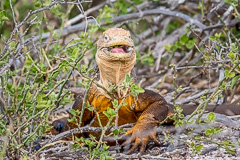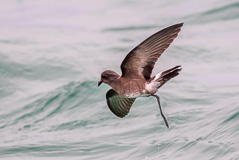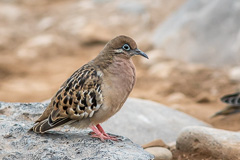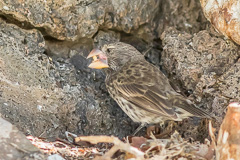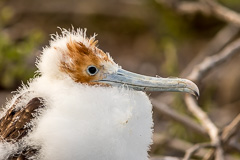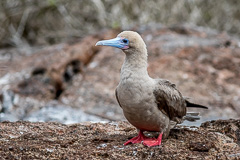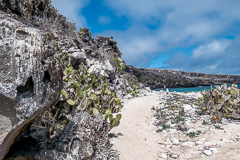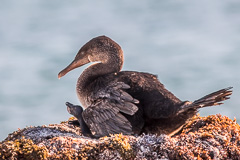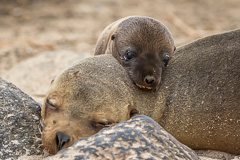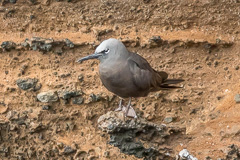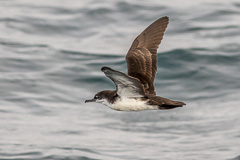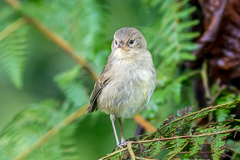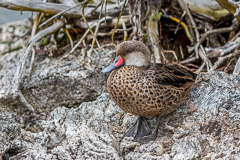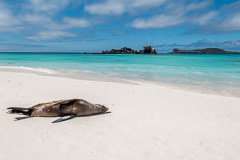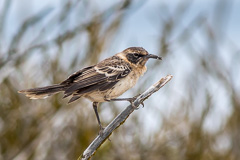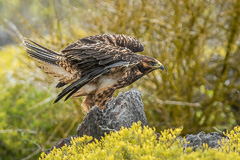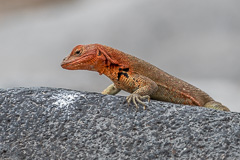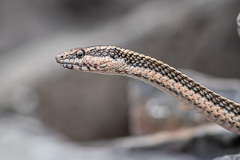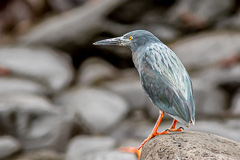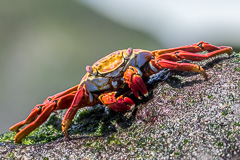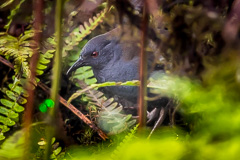Overview
Dates: |
18-26 August 2019. |
With Richard Carden. The Galápagos Islands had long been on our list of places to visit. We'd learned the hard way, with two privately arranged trips caving in at the last minute, that organising private charters in the Galápagos is extremely difficult and frustrating. Limits on boat numbers, suspect operators, increasing tourist numbers, permits and landing slots make for an organisational nightmare. Far easier to join an organised trip; but be sure it's specifically for birders, rather than a generalist tour. In this respect we joined the first ever Rockjumper cruise of these islands.
Usually Rockjumper offers a land-based trip which, although cheaper, by necessity leaves out a couple of remoter localities resulting in a few species being unavailable. Note that current restrictions mean that at least three Galápagos endemics are off limits, even by boat. This trip, led by Forrest Rowland and local guide Hairo, was a great success, and the Galápagos continues to be a fantastic wildlife experience. However, the rising number of tourists mean that restrictions and limited time slots have been introduced at each locality, resulting in the islands losing their sense of adventure, as all now feels canned and regimented. Available trails are short, very easy to walk and lack any challenge. |
Itinerary
17 Aug. This trip was sandwiched within a three week trip encompassing northern Ecuador. An overnight at the Wyndham Hotel at Quito airport where we met the other participants.
18 Aug. We took the early 06:00 shuttle to the airport for the Avianca 08:12 flight to Baltra, via Guayaquil. Although the flight left Quito on time a bit of faffing in Guayaquil meant we landed eventually at 11:20. Travelling into Galápagos one has to deal with the bureaucracy, form-filling and pay a park fee of $100 upon arrival. Immediately outside the terminal building we encountered our first Galápagos endemics, with Medium Ground Finch and Small Ground Finch. A short bus ride to the harbour where we transferred, via zodiac, to the Nemo III, our home on the sea for the next eight days. Weather rather breezy and cool with scattered cloud. Around the harbour were Lava Heron, Elliot's Storm Petrel, American Oystercatcher, Blue-footed Booby and Magnificent Frigatebird. Following lunch on board, we set sail the 30 minutes to Seymore Norte, the small islet just to the north of Baltra. We docked in a choppy sea just offshore, with many Swallow-tailed Gull and Galapagos Shearwater. At 15:00 we took the zodiac to shore to experience first hand how confiding the Galápagos wildlife is. During our two hours on the island we encountered hundreds of Sally Lightfoot Crab, Great Frigatebird, Magnificent Frigatebird, Blue-footed Booby, Swallow-tailed Gull, Galapagos Ground Dove, Galapagos Sea Lion, Galapagos Lava Lizard and Galapagos Land Iguana to mention a few. |
Back on board, we then started the near eight hour, overnight, journey to Genovesa. At only eight knots, the Nemo III was not exactly the fastest boat on the block.
19 Aug. The crossing was a little choppy, so several places were unfilled at dinner. Actually, throughout our trip the weather and sea conditions was decidedly cooler and rougher than expected, and a light waterproof jacket would have been good. Conditions in Galápagos vary considerable with season. At this time of year constant cloud and cool breezes are the norm, with rain pretty much guaranteed in the hills.
We arrived offshore Genovesa at 03:20 and anchored in Darwin Bay. Around the boat in the bay were many Elliot's Storm Petrel, Swallow-tailed Gull, Galapagos Shearwater and Red-billed Tropicbird. Off the boat at 07:00, after which we spent more than three hours on a very short, 500 metre, walk starting from Prince Philip's Steps. The early temperature was only 17°C with a stiff breeze. This interesting stop, with Genovesa Cactus Finch, Large Ground Finch and Genovesa Sharp-billed Finch provided a good introduction into the headaches concerning the identification of Galápagos finches. We experienced the large nesting colonies of Wedge-rumped Storm Petrel plus a couple of Short-eared Owl that predate them continuously. Good numbers of Galapagos Dove, Red-footed Booby and Nazca Booby.
|
Back to boat around 10:00, then an afternoon opportunity for snorkeling, though note that wet suits were required as the water was distinctly on the cool side. We finally left the area at 15:00 and, with the seas becoming rougher, again several people were seasick.
20 Aug. A long 13 hour crossing to Isabela, anchoring first at Vincente Roca at 04:20. Here we spent the first couple of hours in a slow cruise along the rocky shoreline, obtaining our first views of Flightless Cormorant and Galapagos Hawk, plus more Galapagos Shearwater, Brown Noddy, Galapagos Sea Lion and Green Turtle. We continued south, past Tagus cove, with Galapagos Martin and Galapagos Penguin, then as far as Punto Espinosa before crossing to Fernandina, where another snorkeling session was followed by a short afternoon walk. |
Along the way we passed a mother and calf Blue Whale - a long sought after mammal plus several Bryde's Whale. The lava and beaches held many Marine Iguana but not much in the bird line other than a couple of Lava Heron and Galapagos Hawk. Left at 17:30 for the overnight journey around the southern side of Isabela, where more choppy waters encountered, though being in the middle of the night few were awake to experience them.
21 Aug. We arrived offshore of Puerto Villamil, the main town on Isabela, around 05:30. Weather conditions were overcast, mizzle and low cloud, a feature of the south faces of these islands at this time. A short zodiac ride to Puerto Villamil town after which we climbed into an open bus, locally known as a chiva, and drove the 20 kilometres into the hills above town as far as Volcán Sierra Negra. As the weather was quite wet during the first couple of hours, birding was initially slow but in improving conditions we found the majority we were seeking. Paint-billed Crake was a highlight, as this widespread bird is frequently a nemesis, with the Galápagos one of the few good localities to encounter it.
Over our several birding stops, we found finches galore with Woodpecker Finch, Large Tree Finch, Small Tree Finch, Small Ground Finch, Medium Ground Finch and Large Ground Finch. A Dark-billed Cuckoo was a nice bonus, though we struggled with Darwin's Flycatcher, which must be a rapidly declining species and could well be on the way to joining its sister species, the San Cristobal Flycatcher, which was recently declared the first Galápagos extinction. |
Before leaving the island we took a short mangrove walk, finding Semipalmated Plover, White-cheeked Pintail and a single Common Cactus Finch. Back to ship and departure at 14:00 for our longest sailing, 14 hours, to Española. Some sea watching en route gave us a single Band-rumped Storm Petrel, several Galapagos Petrel and a couple of Waved Albatross.
22 Aug. At 06:00 we dropped anchor off Punta Suarez. Another less than calm crossing but at least now most were getting some sea legs. At 07:00 we were ashore, with the usual sea lions and iguanas, but new species included Espanola Lava Lizard, Espanola Racer and Espanola Cactus Finch. The island's Waved Albatross colony is spectacular with many individuals displaying and gliding past effortlessly.
Left at 10:00 and rounded the northern side of the island to Gardner Bay for lunch, snorkeling and a walk on the open beach. Despite being very hot the wildlife still performed, with Brown Pelican, Blue-footed Booby and incredibly tame Galapagos Mockingbirds. Back on board around 16:00 for a general chill-out, relaxation, jacuzzi on the boat and dinner. Life could be worse - and quite a comparison to West Papua where we'd been struggling less than a month ago! We departed the area by 19:00 for the shorter, five hour, crossing to Floreana. |
During the evening we were given a presentation by Hairo concerning the intriguing and sordid history of the earliest settlers of the island. Some undercurrents and tension still appear to exist on the island today. 23 Aug. Breakfast at 06:00 and departure, as usual, at 07:00. A good swell on the disembark was apparently due to some recent seismic activity. Boarded another chiva in town and 15 minutes, ten kilometres, later we arrived at Asilo de la Paz. As expected, the weather was pretty damp and overcast with light rain. Surprisingly, our first bird, in the middle of the road, was a Hudsonian Whimbrel, quickly followed by a Galapagos Flycatcher. We took a short walk in the general vicinity of the Giant Tortoise Program Centre, the old Ritter properties and pirate caves. Our main target here was the very range-restricted Medium Tree Finch, a couple of which were found. Also many Medium Ground Finch, Small Ground Finch and Smooth-billed Ani; the later being deliberately introduced in the 1960s. Back on board we cruised a short way up the coast for a quick visit to Post Box Bay, then to Punta Cormoran where we walked to the lagoon, finding American Flamingo, White-cheeked Pintail, Lava Heron and Wilson's Phalarope. |
A further 20 minutes sailing up the coast brought us our final birding of the day with a close sail-by of Champion Islet, which still harbours a few pairs of Floreana Mockingbird - this species having been extirpated on the main island years ago. As no landing is permitted one has to scan from the boat. It's hard to imagine how such a small islet, which cannot possibly hold more 3-4 pairs, can sustain a viable population. Late afternoon departure for the seven hour crossing to San Cristóbal, on another rough sea.
24 Aug. Arrived at Puerto Baquerizo Moreno just after midnight and awoke to another wet and overcast morning. By zodiac we passed rocks at the harbour entrance for close views of Galapagos Penguin before taking taxis several kilometres into the hills to the Penyasco cemetery.
Despite the rain and generally miserable weather, we quickly found San Cristobal Mockingbird. We then birded adjacent forest edge, scrub and farmland searching for Vegetarian Finch that eventually gave itself up after an hour. Mostly on account of the rain, and having found our targets we then returned to town for coffee and any last minute souvenirs before setting off for Santa Fe around 10:00. During the two hour crossing the weather finally cleared and on arrival we had close views of Humpback Whale. Although Santa Fe held no specific bird targets, an afternoon walk did produce Santa Fe Land Iguana and Santa Fe Lava Lizard. The giant cactus here are impressive. Late afternoon we motored the final leg to Santa Cruz, arriving around 21:10, having now completed a total of 506 nautical miles over 66 hours of sailing. 25 Aug. Said our final good-byes to the crew; both boat and crew were excellent. We then left for shore, to board our bus upon which we spent the whole day. Our initial stop was a rock quarry to try for Darwin's Flycatcher, to no avail, though we did see a close Woodpecker Finch. We then headed up to Cerro Crocker. This last walk of the trip turned out to be the most exercise we had all week, spending two and half hours tramping in the wet, but finally rewarded with good views of Galapagos Crake that we'd missed earlier. After lunch, we passed by Rancho El Chato with American Barn Owl, then to the central highlands where Santa Cruz Giant Tortoise appear to be thriving. Our final stop was the Darwin Centre on the southern coast. Overnight at the Puerto Ayora Ikala Hotel in town, the trip dinner, then a few of us visited a bar to sample local craft beers; middle to average being the general verdict. 26 Aug. Although the main town is on the south side of the island, the airport is located on the north side so that fog does not disrupt flights. A 40 minute bus ride, then a three minute ferry to Baltra. Our final Galápagos endemics were the Medium and Small Ground Finches attending the coffee tables in the terminal café. With our flight on time we arrived Quito by 11:15, said farewell to our travel companions and headed off for our next 18 days in northern Ecuador. |
Galleries
Bird images from this, and other, birding trips.
Travel images from this, and other, birding trips.
Species List
| Baltra | Count | ||
| Elliot's Storm Petrel | Oceanites gracilis | 10 | |
| Lava Heron | Butorides sundevalli | 1 | |
| Brown Pelican | Pelecanus occidentalis | 3 | |
| Magnificent Frigatebird | Fregata magnificens | 10 | |
| Blue-footed Booby | Sula nebouxii | 10 | |
| American Oystercatcher | Haematopus palliatus | 1 | |
| Brown Noddy | Anous stolidus | 10 | |
| Lava Gull | Leucophaeus fuliginosus | 1 | |
| Medium Ground Finch | Geospiza fortis | 2 | |
| Small Ground Finch | Geospiza fuliginosa | 10 | |
| Seymore Norte | Count | ||
| Elliot's Storm Petrel | Oceanites gracilis | 30 | |
| Galapagos Shearwater | Puffinus subalaris | 40 | |
| Red-billed Tropicbird | Phaethon aethereus | 2 | |
| Snowy Egret | Egretta thula | 1 | |
| Brown Pelican | Pelecanus occidentalis | 10 | |
| Magnificent Frigatebird | Fregata magnificens | 30 | |
| Great Frigatebird | Fregata minor | 20 | |
| Blue-footed Booby | Sula nebouxii | 80 | |
| Nazca Booby | Sula granti | 3 | |
| Brown Noddy | Anous stolidus | 20 | |
| Swallow-tailed Gull | Creagrus furcatus | 6 | |
| Lava Gull | Leucophaeus fuliginosus | 5 | |
| Galapagos Dove | Zenaida galapagoensis | 10 | |
| Mangrove Warbler | Setophaga petechia | 6 | |
| Large Ground Finch | Geospiza magnirostris | 1 | |
| Medium Ground Finch | Geospiza fortis | 3 | |
| Small Ground Finch | Geospiza fuliginosa | 10 | |
| Genovesa | Count | ||
| Elliot's Storm Petrel | Oceanites gracilis | 40 | |
| Wedge-rumped Storm Petrel | Hydrobates tethys | 900 | |
| Band-rumped Storm Petrel | Hydrobates castro | 1 | |
| Galapagos Petrel | Pterodroma phaeopygia | 6 | |
| Galapagos Shearwater | Puffinus subalaris | 200 | |
| Red-billed Tropicbird | Phaethon aethereus | 12 | |
| Yellow-crowned Night Heron | Nyctanassa violacea | 2 | |
| Brown Pelican | Pelecanus occidentalis | 4 | |
| Great Frigatebird | Fregata minor | 40 | |
| Nazca Booby | Sula granti | 40 | |
| Red-footed Booby | Sula sula | 50 | |
| Ruddy Turnstone | Arenaria interpres | 3 | |
| Wandering Tattler | Tringa incana | 1 | |
| Brown Noddy | Anous stolidus | 30 | |
| Swallow-tailed Gull | Creagrus furcatus | 30 | |
| Galapagos Dove | Zenaida galapagoensis | 25 | |
| Short-eared Owl | Asio flammeus | 2 | |
| Galapagos Mockingbird | Mimus parvulus | 6 | |
| Mangrove Warbler | Setophaga petechia | 6 | |
| Large Ground Finch | Geospiza magnirostris | 5 | |
| Genovesa Ground Finch | Geospiza acutirostris | 20 | |
| Genovesa Cactus Finch | Geospiza propinqua | 2 | |
| Grey Warbler Finch | Certhidea fusca | 3 | |
| Isabela | Count | ||
| White-cheeked Pintail | Anas bahamensis | 6 | |
| Galapagos Penguin | Spheniscus mendiculus | 10 | |
| Elliot's Storm Petrel | Oceanites gracilis | 30 | |
| Waved Albatross | Phoebastria irrorata | 2 | |
| Wedge-rumped Storm Petrel | Hydrobates tethys | 5 | |
| Band-rumped Storm Peterl | Hydrobates castro | 1 | |
| Galapagos Petrel | Pterodroma phaeopygia | 2 | |
| Galapagos Shearwater | Puffinus subalaris | 300 | |
| Red-billed Tropicbird | Phaethon aethereus | 4 | |
| American Flamingo | Phoenicopterus ruber | 5 | |
| Brown Pelican | Pelecanus occidentalis | 12 | |
| Striated Heron | Butorides striata | 1 | |
| Western Cattle Egret | Ardea ibis | 6 | |
| Great Blue Heron | Ardea herodias | 1 | |
| Great Frigatebird | Fregata minor | 10 | |
| Magnificent Frigatebird | Fregata magnificens | 2 | |
| Blue-footed Booby | Sula nebouxii | 20 | |
| Nazca Booby | Sula granti | 10 | |
| Flightless Cormorant | Nannopterum harrisi | 12 | |
| Galapagos Crake | Mustelirallus erythrops | h | |
| Paint-billed Crake | Neocrex erythrops | 2 | |
| Galapagos Hawk | Buteo galapagoensis | 3 | |
| American Coot | Gallinula galeata | 1 | |
| Common Gallinule | Gallinula galeata | 2 | |
| American Oystercatcher | Haematopus palliatus | 1 | |
| Black-necked Stilt | Himantopus mexicanus | 4 | |
| Red-necked Phalarope | Phalaropus lobatus | 500 | |
| Red Phalarope | Phalaropus fulicarius | 1 | |
| Grey Plover | Pluvialis squatarola | 2 | |
| Semipalmated Plover | Charadrius semipalmatus | 2 | |
| Hudsonian Whimbrel | Numenius hudsonicus | 2 | |
| Wandering Tattler | Tringa incana | 10 | |
| Brown Noddy | Anous stolidus | 200 | |
| Lava Gull | Leucophaeus fuliginosus | 1 | |
| Swallow-tailed Gull | Creagrus furcatus | 6 | |
| Smooth-billed Ani | Crotophaga ani | 6 | |
| Dark-billed Cuckoo | Coccyzus melacoryphus | 2 | |
| Galapagos Martin | Progne modesta | 8 | |
| Darwin's Flycatcher | Pyrocephalus nanus | 2 | |
| Galapagos Mockingbird | Mimus parvulus | 3 | |
| Mangrove Warbler | Setophaga petechia | 4 | |
| Large Ground Finch | Geospiza magnirostris | 6 | |
| Medium Ground Finch | Geospiza fortis | 10 | |
| Small Ground Finch | Geospiza fuliginosa | 30 | |
| Common Cactus Finch | Geospiza scandens | 1 | |
| Large Tree Finch | Camarhynchus psittacula | 6 | |
| Small Tree Finch | Camarhynchus parvulus | 5 | |
| Woodpecker Finch | Camarhynchus pallidus | 3 | |
| Green Warbler Finch | Certhidea olivacea | 6 | |
| Fernandina | Count | ||
| Lava Heron | Butorides sundevalli | 1 | |
| Great Frigatebird | Fregata minor | 5 | |
| Flightless Cormorant | Nannopterum harrisi | 4 | |
| Galapagos Hawk | Buteo galapagoensis | 1 | |
| American Oystercatcher | Haematopus palliatus | 2 | |
| Hudsonian Whimbrel | Numenius hudsonicus | 1 | |
| Wandering Tattler | Tringa incana | 2 | |
| Brown Noddy | Anous stolidus | 4 | |
| Galapagos Mockingbird | Mimus parvulus | 2 | |
| Mangrove Warbler | Setophaga petechia | 2 | |
| Española | Count | ||
| Elliot's Storm Petrel | Oceanites gracilis | 5 | |
| Waved Albatross | Phoebastria irrorata | 30 | |
| Wedge-rumped Storm Petrel | Hydrobates tethys | 1 | |
| Galapagos Shearwater | Puffinus subalaris | 4 | |
| Red-billed Tropicbird | Phaethon aethereus | 8 | |
| Yellow-crowned Night Heron | Nyctanassa violacea | 2 | |
| Lava Heron | Butorides sundevalli | 2 | |
| Brown Pelican | Pelecanus occidentalis | 1 | |
| Great Frigatebird | Fregata minor | 4 | |
| Blue-footed Booby | Sula nebouxii | 20 | |
| Nazca Booby | Sula granti | 30 | |
| Galapagos Hawk | Buteo galapagoensis | 3 | |
| Spotted Sandpiper | Actitis macularius | 1 | |
| Wandering Tattler | Tringa incana | 5 | |
| Swallow-tailed Gull | Creagrus furcatus | 20 | |
| Galapagos Dove | Zenaida galapagoensis | 10 | |
| Española Mockingbird | Mimus macdonaldi | 15 | |
| Mangrove Warbler | Setophaga petechia | 4 | |
| Espanola Cactus Finch | Geospiza conirostris | 4 | |
| Small Ground Finch | Geospiza fuliginosa | 6 | |
| Grey Warbler Finch | Certhidea fusca | 4 | |
| Floreana / Champion | Count | ||
| White-cheeked Pintail | Anas bahamensis | 1 | |
| Galapagos Penguin | Spheniscus mendiculus | 1 | |
| Elliot's Storm Petrel | Oceanites gracilis | 12 | |
| Wedge-rumped Storm Petrel | Hydrobates tethys | 1 | |
| Galapagos Shearwater | Puffinus subalaris | 10 | |
| American Flamingo | Phoenicopterus ruber | 16 | |
| Red-billed Tropicbird | Phaethon aethereus | 4 | |
| Yellow-crowned Night Heron | Nyctanassa violacea | 1 | |
| Lava Heron | Butorides sundevalli | 1 | |
| Western Cattle Egret | Ardea ibis | 3 | |
| Brown Pelican | Pelecanus occidentalis | 3 | |
| Magnificent Frigatebird | Fregata magnificens | 3 | |
| Blue-footed Booby | Sula nebouxii | 20 | |
| Nazca Booby | Sula granti | 5 | |
| Hudsonian Whimbrel | Numenius hudsonicus | 1 | |
| Wilson's Phalarope | Phalaropus tricolor | 1 | |
| Red-necked Phalarope | Phalaropus lobatus | 4 | |
| Brown Noddy | Anous stolidus | 20 | |
| Swallow-tailed Gull | Creagrus furcatus | 10 | |
| Smooth-billed Ani | Crotophaga ani | 10 | |
| Galapagos Flycatcher | Myiarchus magnirostris | 3 | |
| Floreana Mockingbird | Mimus trifasciatus | 2 | |
| Mangrove Warbler | Setophaga petechia | 6 | |
| Medium Ground Finch | Geospiza fortis | 20 | |
| Small Ground Finch | Geospiza fuliginosa | 10 | |
| Medium Tree Finch | Camarhynchus pauper | 2 | |
| Small Tree Finch | Camarhynchus parvulus | 3 | |
| San Cristóbal | Count | ||
| Elliot's Storm Petrel | Oceanites gracilis | 6 | |
| Waved Albatross | Phoebastria irrorata | 3 | |
| Wedge-rumped Storm Petrel | Hydrobates tethys | 2 | |
| Galapagos Petrel | Pterodroma phaeopygia | 1 | |
| Galapagos Shearwater | Puffinus subalaris | 10 | |
| Red-billed Tropicbird | Phaethon aethereus | 2 | |
| Yellow-crowned Night Heron | Nyctanassa violacea | 1 | |
| Brown Pelican | Pelecanus occidentalis | 2 | |
| Magnificent Frigatebird | Fregata magnificens | 2 | |
| Brown Noddy | Anous stolidus | 10 | |
| Smooth-billed Ani | Crotophaga ani | 3 | |
| Galapagos Flycatcher | Myiarchus magnirostris | 1 | |
| San Cristobal Mockingbird | Mimus melanotis | 2 | |
| Mangrove Warbler | Setophaga petechia | 6 | |
| Medium Ground Finch | Geospiza fortis | 15 | |
| Small Ground Finch | Geospiza fuliginosa | 6 | |
| Vegetarian Finch | Platyspiza crassirostris | 2 | |
| Small Tree Finch | Camarhynchus parvulus | 4 | |
| Woodpecker Finch | Camarhynchus pallidus | 2 | |
| Grey Warbler Finch | Certhidea fusca | 4 | |
| Santa Fe | Count | ||
| Elliot's Storm Petrel | Oceanites gracilis | 2 | |
| Magnificent Frigatebird | Fregata magnificens | 10 | |
| Nazca Booby | Sula granti | 2 | |
| Wandering Tattler | Tringa incana | 2 | |
| Galapagos Mockingbird | Mimus parvulus | 4 | |
| Mangrove Warbler | Setophaga petechia | 3 | |
| Small Ground Finch | Geospiza fuliginosa | 4 | |
| Santa Cruz | Count | ||
| Elliot's Storm Petrel | Oceanites gracilis | 3 | |
| Western Cattle Egret | Ardea ibis | 2 | |
| Brown Pelican | Pelecanus occidentalis | 4 | |
| Magnificent Frigatebird | Fregata magnificens | 5 | |
| Blue-footed Booby | Sula nebouxii | 2 | |
| Galapagos Crake | Laterallus spilonota | 5 | |
| Lava Gull - E | Leucophaeus fuliginosus | 1 | |
| Galapagos Dove | Zenaida galapagoensis | 3 | |
| Smooth-billed Ani | Crotophaga ani | 3 | |
| American Barn Owl | Tyto furcata | 2 | |
| Galapagos Flycatcher | Myiarchus magnirostris | 3 | |
| Galapagos Mockingbird | Mimus parvulus | 2 | |
| Mangrove Warbler | Setophaga petechia | 4 | |
| Medium Ground Finch | Geospiza fortis | 10 | |
| Small Ground Finch | Geospiza fuliginosa | 20 | |
| Common Cactus Finch | Geospiza scandens | 2 | |
| Vegetarian Finch | Platyspiza crassirostris | 2 | |
| Large Tree Finch | Camarhynchus psittacula | 2 | |
| Small Tree Finch | Camarhynchus parvulus | 1 | |
| Woodpecker Finch | Camarhynchus pallidus | 1 | |
| Green Warbler Finch | Certhidea olivacea | 3 |

